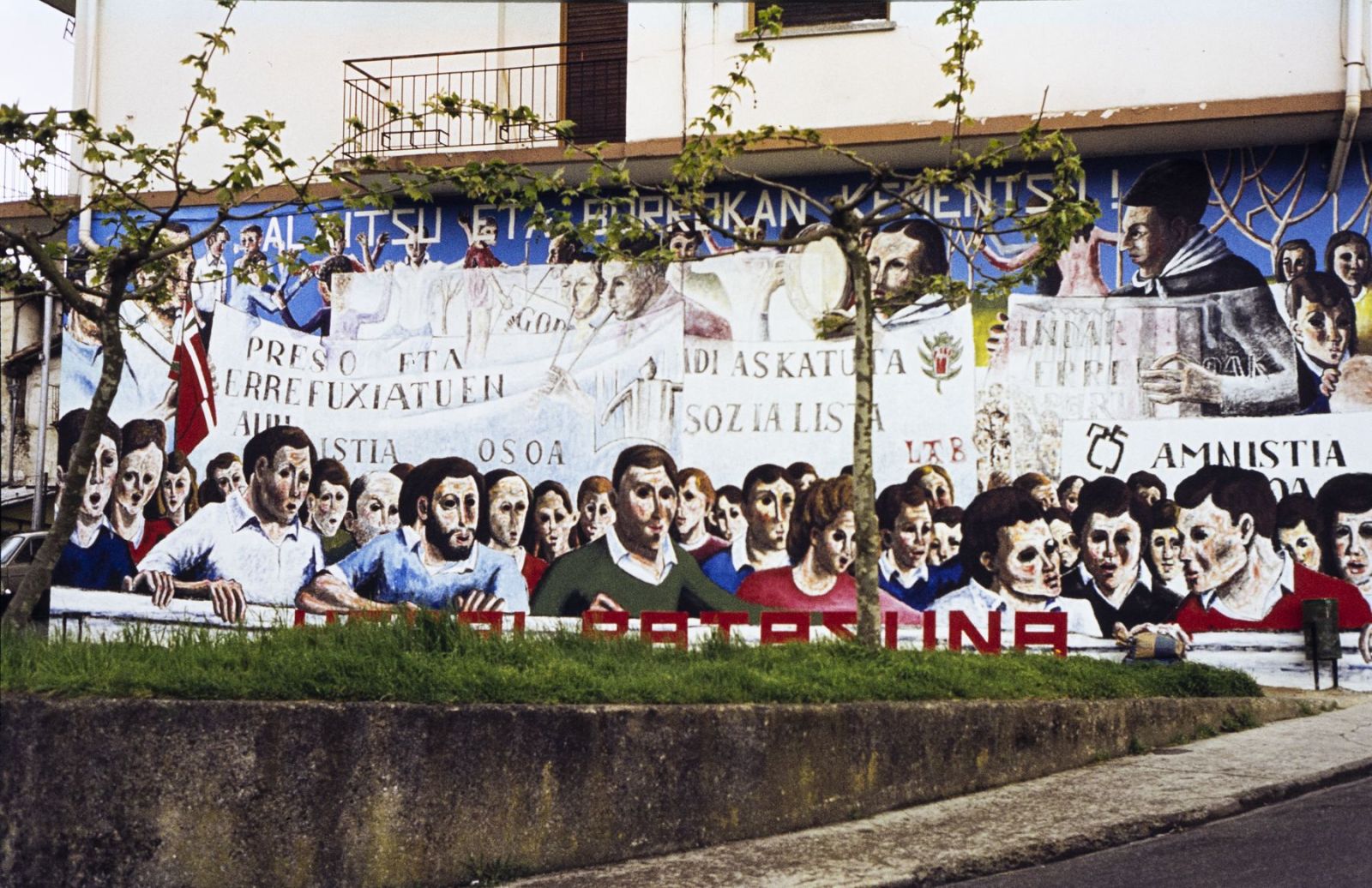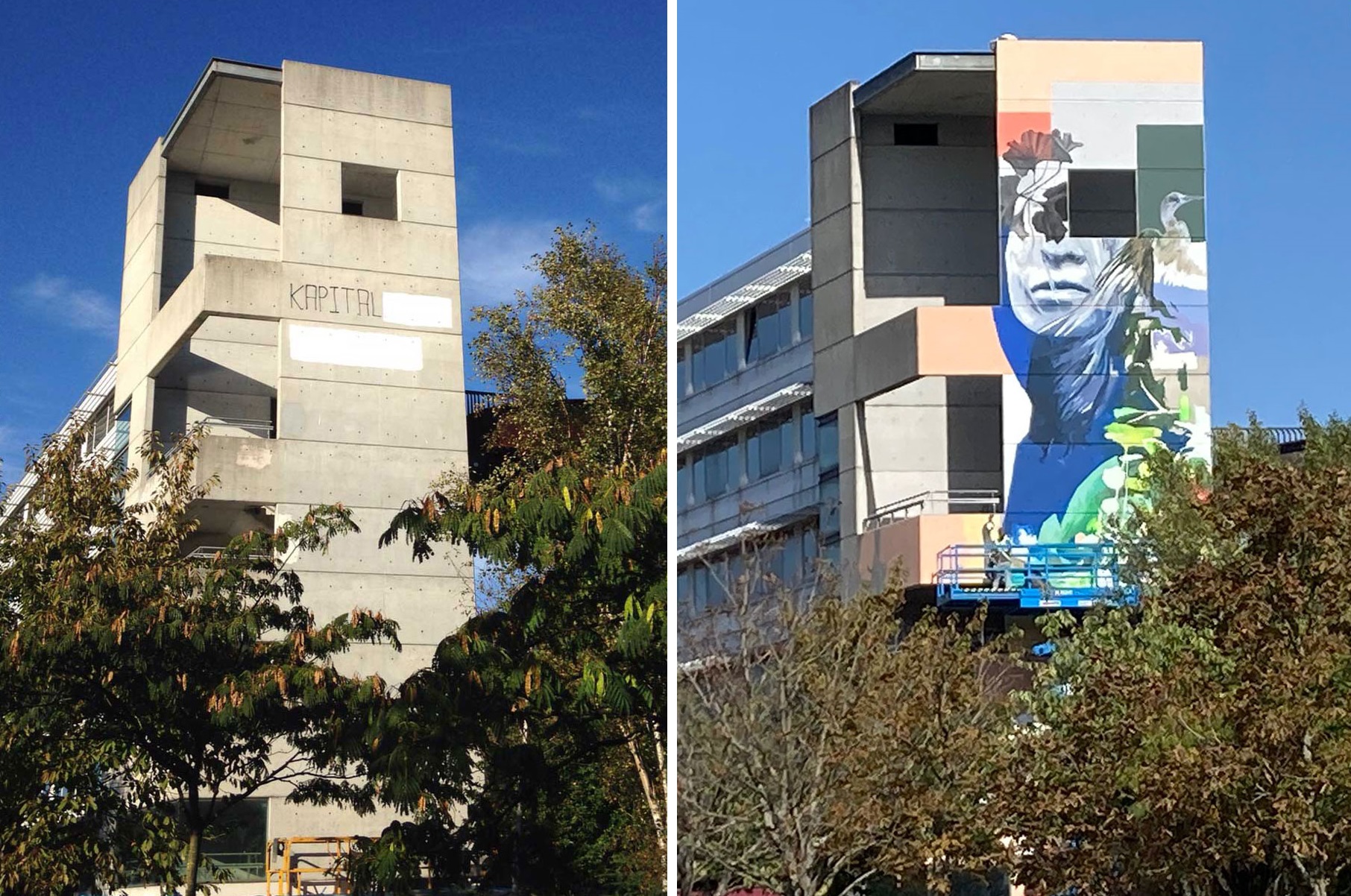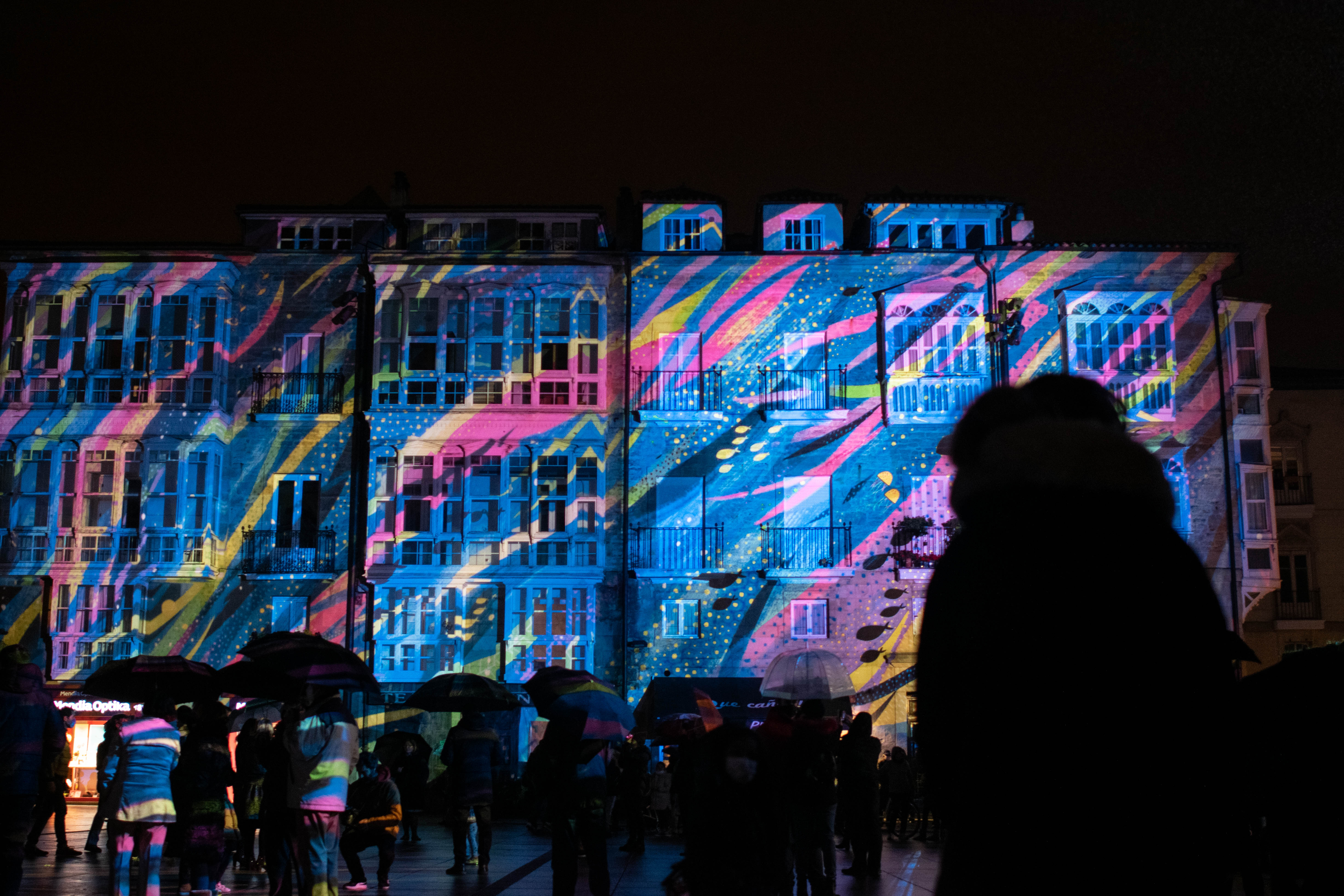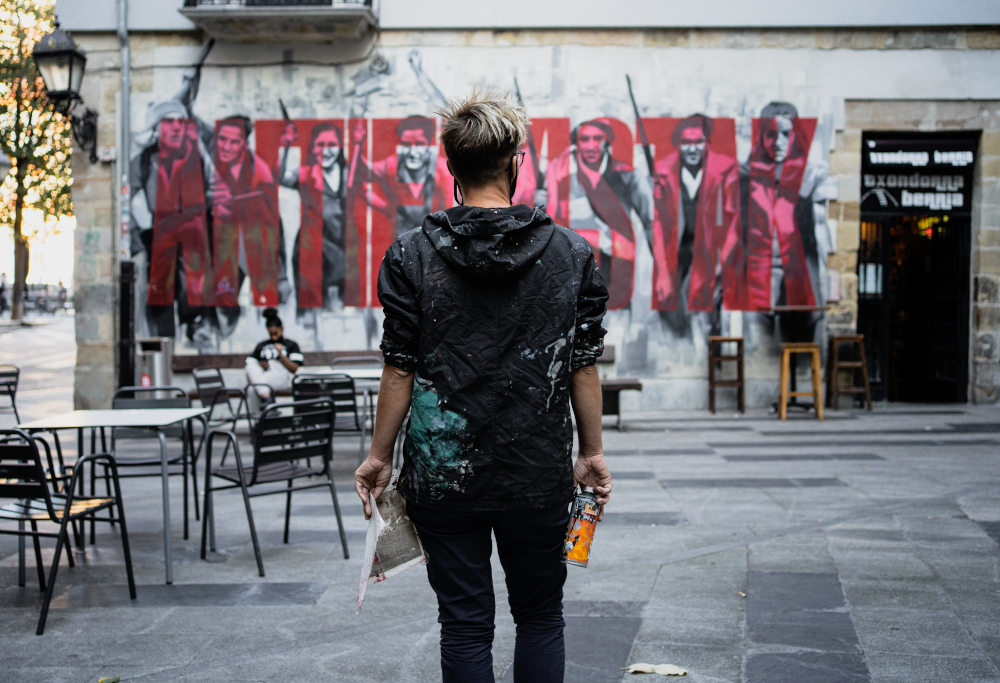Living walls above censorship and oblivion
- “The walls talk about what the media are silencing,” a Barakaldo mural in Spanish in the 1990s aimed at highlighting the main role of murals and paintings. They are anonymous voices, which speak of the written word on the wall, spontaneous mostly, demands and direct criticism on common themes, reflecting the will to change the reality of the time. The thirteenth monographic work carried out by the archaeologist and writer Xabier Peñalver and published by the Fundación Memoria Vasca has made a valuable contribution to “recover” and value this vindictive legacy that censorship and desidia have carried out in the Basque Country. Today, because the walls speak.

Xabier Peñalver has been immersed in the defense of heritage for decades, but always related to research. Because he understands that if heritage is not preserved, there is no research or knowledge. “More in such an aggressive and devastating society.” Peñalver is known in archaeology and during the last two decades has been especially prominent in the defense of the Praileaitz of Deba. These high-value caves and deposits are threatened by a quarry of the company Amenabar.
In Praileaitz, in addition to the abundance of objects and information of their ancestors, the walls are decorated with paintings made more than 18,000 years ago. Since then we have changed a lot, but the human being still has the same need to share thoughts and concerns with the community. And for that, the best meeting place is public space, cave walls or a corner wall of the current town square. The desire to express oneself is in us, but unfortunately also the desire to eliminate what we do not like. “Murals are a heritage that cannot be excavated in the future, they will not be collected in any file, because, by censorship, in most cases and over time, they disappear.” That's the motivation that has led Xabier Peñalver to make the book. In the book, in collaboration with the carabiner Maite Marañon, he collected about 1,000 murals of the 4,000 he has documented with his cameras since 1981. This passion has led him to travel all over the Basque Country over the last four decades, photographing his walls to gather that anonymous heritage that reflects the demands of the time.



We've always had murals with each other. Even though they have been part of the landscape, Peñalver clearly says that very few would think of documenting, making a photo. “Now I want to think that when you make a mural, people in the area will take pictures of you, and maybe some tourist, but before you did not. The camera didn't take you in your pocket, and even when you were there, like press photographers, you didn't pick up the murals. Now a lot of photos are made, but they're getting deleted. I don’t know how much will remain from there in the future.”
In the book foreword, Eugenio Etxebeste Antton states that spontaneous critical expression has been considerably reduced. This crude statement is not surprising if we look at our public space. In the street, private properties have proliferated, with surveillance cameras, both police and private, the corners are sewn and the plazas are adorned by signs of “prohibition of doing this or other”. Peñalver related it to the political environment: “The rhythms of what some call conflict and other struggles have changed, now we are not in a time of confrontation and that is reflected in the street. However, other issues are emerging.”



Society is constantly changing and its demands. The first walls received messages against NATO
or the Lemoiz nuclear power plant or for amnesty. The struggles that were once in the background have been gaining space on the street. Feminism is a good reflection of this, according to Peñalver. “The struggle of women is also one of the few exceptions, because it is sufficiently respected. For power, it’s harder to censor her messages, and that, of course, is not casual, it’s a result of the work and struggle of feminists.” Peñalver also highlighted the war and historical memory of 1936: “Before only the guerneries were painted, but in recent years many and various things related to historical memory have been painted. The murals’ themes change with society, although some issues, four decades later, remain present, such as political prisoners and torture.”



The Street Art Cities platform selects each year the best murals in the world. Among the 2022 candidates, three murals have been selected in the Basque Country and one of them, the muralist Lian in Ondarroa, has just received the third prize. It is evident that the number of murals has decreased, but Peñalver says he has gained a lot in quality. “Today there are huge murals, professional artists enter the world of murals. For example, Lian does amazing things, like those painted in the building that was the headquarters of the Civil Guard of Leitza or in the Bilbao La Vieja. The Irish houses of Errekaleor are spectacular. In Vitoria-Gasteiz, near the site where the strikers of March 3 were killed, the work done on the facade of a building annexed to the church of San Francisco is also exciting. Today they become very good murals.”
30 or 40 years ago, in the neighborhoods, people who couldn't draw and paint would take the street and make mural. The objective was to socialize local demands and concerns, regardless of their artistic aspect. They were like a 1981 Sestao mural, next to the simple drawing of an old school surrounded by rats that said “good schools now.” “These murals were of great importance, although artistically modest. They influenced people, not by the artistic, but by the message, which is the most important part of the murals.” Among them, of course, there are some who have been stuck in the memory of many, many of them linked to concrete and very hard moments in the history of the Basque Country. In this sense, Peñalver recalls the murals made after the tortured death of Joseba Arrangi. “I find the murals that are now being made to beautify some sites, those of paying artists, very good, but those are something else. The aesthetic and vindictive side can be united, but the function of the murals is not only aesthetic”. That is why he has focused on the book in the vindictive character of the murals and not only on the artistic point of view.
%2025-8-2021%20IMG_2879%20(36).jpg)


_06_2018).jpg)
Organized into 17 themes, the book collects all kinds of murals in terms of content, style, artistic quality, format and location. But the vast majority have the same characteristic: they only exist in the pictures. “The Basque Country is not like Ireland, therefore has wall restoration groups that have turned the murals into tourist claims and historical memory instruments. But there's hardly anything left here, we only have news, which you're painting now. Fortunately, it is still painted on the street and also very strong things. But all of this has disappeared.” And of course, censorship is the main reason.
Who sets the limits of freedom of expression? The question is older than hunger. It is difficult to answer and also varies according to the times, mainly the
relations of strength between the citizen movement and power. Naomi Klein noted in his famous book No logo: Taking Aim at the Brand Bullies that when they criminalize the street expression of citizens they are criminalizing what is truly public in the lives of towns and cities. Because those who want to control the use of public space, those who pursue any mural and graphic expression on the street, do not act the same way when it comes to transmitting their message to taste or turning public places into advertising media.
Peñalver recognizes that it is a complicated issue, but “if the street is of all, those who occupy a position of responsibility must ensure that the street remains of all. And yes, there may be things that are not politically correct, that have to be resolved or removed from the conflict. But most is not that. Murals about the right to decide, the rights of women, the Korrika… They have the basic demands removed, because the mayor has said that nothing is painted here because he believes that his word is worth more than the other, because he has obtained more votes in the elections than the others. It makes no sense, and I also think there are few people who defend this stubborn stance.”
What is dirty and clean? Another difficult question, which generates contradictions and often very curious attitudes. Peñalver recalls what happened during the last decade in Pamplona, ruled by UPN. “The City Hall was not able to remove all the posters that people put on the street and then decided to paint the posters, stain them with gray paint. Thus, in the areas where the walls were placed the most, they were filled with grey municipal offices. In any case, the City Hall continued to say that the posters were dirty. With such attitudes, how can you not be surprised?”
.jpg)
Those who want to drive out certain messages often use every means at their disposal. Censorship is very old, but it is evident that in the last two decades this sense of control has intensified and spread. “The situation has gone to worse, yes. Today it seems that painting something on the street is a claim in itself.” For this reason, Peñalver has described as "spectacular" what happened in Zumaia between 2016 and 2019, recalling the efforts of Calle De Todos. “Every time the people of the town painted the mural on a small wall in the old town, the municipal government systematically eliminated it with brown paint. People would repaint another different mural and the city council would delete it for the next morning. And so they painted and censored 98 murals. They were very different themes, such as the defense of the Basque Country, the denunciation of the case of La Manada, the literary characters, a Guernica… The enthusiasm of its people must be highlighted. Knowing that in a few hours his work was to be erased, they did not stop painting murals for three years, on the street and with daylight, to claim freedom of expression.”

Apart from Zumaia, Peñalver highlights another case as an icon of the absurdity of censorship: the mural of Alejandro Tapia in 1985 in Usurbil. It's a mural made on the front of a house. Several anonymous people appear, with various demands and an ikurrina, behind a banner that says Herri Batasuna. In 2009, commissioned by the government of Patxi López, the Ertzaintza censored the mural, covering the phrase Herri Batasuna and the faces of people with gray paint, trash. “These people, in quotation marks, were murdered, their bodies were not erased, their heads were removed. They also tried to eliminate ikurrina, but someone made them rebuke if ikurrina bothers them.” The tapia did not want to restore the mural and since then, in a clumsy and odious way, a censored version is shown on the wall accompanied by a plate that explains the meaning of the mural and its censorship.
.jpg)
“Many such things have happened and are happening, while murals and graffiti are sold in hundreds of thousands of dollars in art galleries,” Peñalver says. Because “censorship, like repression, has no complexes and censors never learn.” That is why they are necessary as the ant work carried out by Peñalver. More than to remember the painting, to remind everyone that claiming public space is the best way to cope with the prohibitive and controlling impulse that reigns today. Because, as before, we need other spaces to relate and express ourselves. Even more so in times of media saturation.

Zerbitzu sekretuen alorrean erabili ohi diren OSINT teknikak erabiliko dituen enpresa bat kontratatzeko proiektua lizitaziora atera du Gasteizko Udalak, Arabako Alea-k jakitera eman duenez.
These cold nights of November the street of Vitoria does not illuminate the moons, but the shows of the festival of light Umbra. In these short days of little light, the festival has allowed us to enter the world of the art of light, where the public has been able to experience... [+]

























